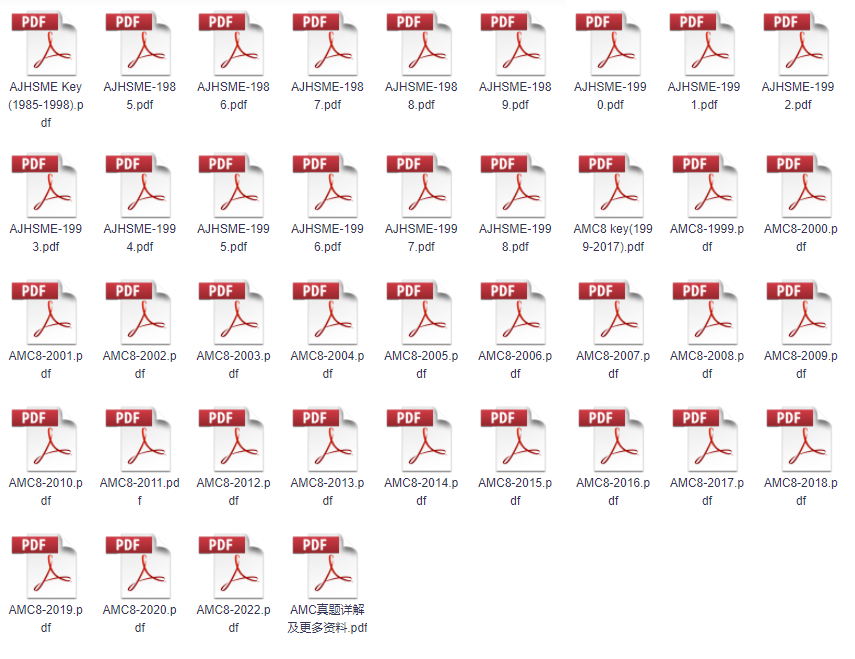2023年AMC 8 真题:
Problem 1
What is the value of ![]() ?
?
![]()
Problem 2
A square piece of paper is folded twice into four equal quarters, as shown below, then cut along the dashed line. When unfolded, the paper will match which of the following figures?![[asy] //Restored original diagram. Alter it if you would like, but it was made by TheMathGuyd, // Diagram by TheMathGuyd. I even put the lined texture :) // Thank you Kante314 for inspiring thicker arrows. They do look much better size(0,3cm); path sq = (-0.5,-0.5)--(0.5,-0.5)--(0.5,0.5)--(-0.5,0.5)--cycle; path rh = (-0.125,-0.125)--(0.5,-0.5)--(0.5,0.5)--(-0.125,0.875)--cycle; path sqA = (-0.5,-0.5)--(-0.25,-0.5)--(0,-0.25)--(0.25,-0.5)--(0.5,-0.5)--(0.5,-0.25)--(0.25,0)--(0.5,0.25)--(0.5,0.5)--(0.25,0.5)--(0,0.25)--(-0.25,0.5)--(-0.5,0.5)--(-0.5,0.25)--(-0.25,0)--(-0.5,-0.25)--cycle; path sqB = (-0.5,-0.5)--(-0.25,-0.5)--(0,-0.25)--(0.25,-0.5)--(0.5,-0.5)--(0.5,0.5)--(0.25,0.5)--(0,0.25)--(-0.25,0.5)--(-0.5,0.5)--cycle; path sqC = (-0.25,-0.25)--(0.25,-0.25)--(0.25,0.25)--(-0.25,0.25)--cycle; path trD = (-0.25,0)--(0.25,0)--(0,0.25)--cycle; path sqE = (-0.25,0)--(0,-0.25)--(0.25,0)--(0,0.25)--cycle; filldraw(sq,mediumgrey,black); draw((0.75,0)--(1.25,0),currentpen+1,Arrow(size=6)); //folding path sqside = (-0.5,-0.5)--(0.5,-0.5); path rhside = (-0.125,-0.125)--(0.5,-0.5); transform fld = shift((1.75,0))*scale(0.5); draw(fld*sq,black); int i; for(i=0; i<10; i=i+1) { draw(shift(0,0.05*i)*fld*sqside,deepblue); } path rhedge = (-0.125,-0.125)--(-0.125,0.8)--(-0.2,0.85)--cycle; filldraw(fld*rhedge,grey); path sqedge = (-0.5,-0.5)--(-0.5,0.4475)--(-0.575,0.45)--cycle; filldraw(fld*sqedge,grey); filldraw(fld*rh,white,black); int i; for(i=0; i<10; i=i+1) { draw(shift(0,0.05*i)*fld*rhside,deepblue); } draw((2.25,0)--(2.75,0),currentpen+1,Arrow(size=6)); //cutting transform cut = shift((3.25,0))*scale(0.5); draw(shift((-0.01,+0.01))*cut*sq); draw(cut*sq); filldraw(shift((0.01,-0.01))*cut*sq,white,black); int j; for(j=0; j<10; j=j+1) { draw(shift(0,0.05*j)*cut*sqside,deepblue); } draw(shift((0.01,-0.01))*cut*(0,-0.5)--shift((0.01,-0.01))*cut*(0.5,0),dashed); //Answers Below, but already Separated //filldraw(sqA,grey,black); //filldraw(sqB,grey,black); //filldraw(sq,grey,black); //filldraw(sqC,white,black); //filldraw(sq,grey,black); //filldraw(trD,white,black); //filldraw(sq,grey,black); //filldraw(sqE,white,black); [/asy]](https://latex.artofproblemsolving.com/6/d/3/6d385621437744e469b64fd20d5c8183e9e93ac1.png)
![[asy] // Diagram by TheMathGuyd. size(0,7.5cm); path sq = (-0.5,-0.5)--(0.5,-0.5)--(0.5,0.5)--(-0.5,0.5)--cycle; path rh = (-0.125,-0.125)--(0.5,-0.5)--(0.5,0.5)--(-0.125,0.875)--cycle; path sqA = (-0.5,-0.5)--(-0.25,-0.5)--(0,-0.25)--(0.25,-0.5)--(0.5,-0.5)--(0.5,-0.25)--(0.25,0)--(0.5,0.25)--(0.5,0.5)--(0.25,0.5)--(0,0.25)--(-0.25,0.5)--(-0.5,0.5)--(-0.5,0.25)--(-0.25,0)--(-0.5,-0.25)--cycle; path sqB = (-0.5,-0.5)--(-0.25,-0.5)--(0,-0.25)--(0.25,-0.5)--(0.5,-0.5)--(0.5,0.5)--(0.25,0.5)--(0,0.25)--(-0.25,0.5)--(-0.5,0.5)--cycle; path sqC = (-0.25,-0.25)--(0.25,-0.25)--(0.25,0.25)--(-0.25,0.25)--cycle; path trD = (-0.25,0)--(0.25,0)--(0,0.25)--cycle; path sqE = (-0.25,0)--(0,-0.25)--(0.25,0)--(0,0.25)--cycle; //ANSWERS real sh = 1.5; label("$\textbf{(A)}$",(-0.5,0.5),SW); label("$\textbf{(B)}$",shift((sh,0))*(-0.5,0.5),SW); label("$\textbf{(C)}$",shift((2sh,0))*(-0.5,0.5),SW); label("$\textbf{(D)}$",shift((0,-sh))*(-0.5,0.5),SW); label("$\textbf{(E)}$",shift((sh,-sh))*(-0.5,0.5),SW); filldraw(sqA,mediumgrey,black); filldraw(shift((sh,0))*sqB,mediumgrey,black); filldraw(shift((2*sh,0))*sq,mediumgrey,black); filldraw(shift((2*sh,0))*sqC,white,black); filldraw(shift((0,-sh))*sq,mediumgrey,black); filldraw(shift((0,-sh))*trD,white,black); filldraw(shift((sh,-sh))*sq,mediumgrey,black); filldraw(shift((sh,-sh))*sqE,white,black); [/asy]](https://latex.artofproblemsolving.com/0/f/8/0f8ca5448d7ae5672368a192ed9ee5af7a40419b.png)
Problem 3
Wind chill is a measure of how cold people feel when exposed to wind outside. A good estimate for wind chill can be found using this calculation![]() where temperature is measured in degrees Fahrenheit
where temperature is measured in degrees Fahrenheit ![]() and the wind speed is measured in miles per hour (mph). Suppose the air temperature is
and the wind speed is measured in miles per hour (mph). Suppose the air temperature is ![]() and the wind speed is
and the wind speed is ![]() mph. Which of the following is closest to the approximate wind chill?
mph. Which of the following is closest to the approximate wind chill?
![]()
Problem 4
The numbers from ![]() to
to ![]() are arranged in a spiral pattern on a square grid, beginning at the center. The first few numbers have been entered into the grid below. Consider the four numbers that will appear in the shaded squares, on the same diagonal as the number
are arranged in a spiral pattern on a square grid, beginning at the center. The first few numbers have been entered into the grid below. Consider the four numbers that will appear in the shaded squares, on the same diagonal as the number ![]() How many of these four numbers are prime?
How many of these four numbers are prime?![[asy] /* Made by MRENTHUSIASM */ size(175); void ds(pair p) { filldraw((0.5,0.5)+p--(-0.5,0.5)+p--(-0.5,-0.5)+p--(0.5,-0.5)+p--cycle,mediumgrey); } ds((0.5,4.5)); ds((1.5,3.5)); ds((3.5,1.5)); ds((4.5,0.5)); add(grid(7,7,grey+linewidth(1.25))); int adj = 1; int curUp = 2; int curLeft = 4; int curDown = 6; label("$1$",(3.5,3.5)); for (int len = 3; len<=3; len+=2) { for (int i=1; i<=len-1; ++i) { label("$"+string(curUp)+"$",(3.5+adj,3.5-adj+i)); label("$"+string(curLeft)+"$",(3.5+adj-i,3.5+adj)); label("$"+string(curDown)+"$",(3.5-adj,3.5+adj-i)); ++curDown; ++curLeft; ++curUp; } ++adj; curUp = len^2 + 1; curLeft = len^2 + len + 2; curDown = len^2 + 2*len + 3; } draw((4,4)--(3,4)--(3,3)--(5,3)--(5,5)--(2,5)--(2,2)--(6,2)--(6,6)--(1,6)--(1,1)--(7,1)--(7,7)--(0,7)--(0,0)--(7,0),linewidth(2)); [/asy]](https://latex.artofproblemsolving.com/6/e/8/6e88180afd53a16ea3b9e0389e44933a31876e70.png)
![]()
Problem 5
A lake contains ![]() trout, along with a variety of other fish. When a marine biologist catches and releases a sample of
trout, along with a variety of other fish. When a marine biologist catches and releases a sample of ![]() fish from the lake,
fish from the lake, ![]() are identified as trout. Assume that the ratio of trout to the total number of fish is the same in both the sample and the lake. How many fish are there in the lake?
are identified as trout. Assume that the ratio of trout to the total number of fish is the same in both the sample and the lake. How many fish are there in the lake?
![]()
Problem 6
The digits ![]() and
and ![]() are placed in the expression below, one digit per box. What is the maximum possible value of the expression?
are placed in the expression below, one digit per box. What is the maximum possible value of the expression?
![[asy] // Diagram by TheMathGuyd. I can compress this later size(5cm); real w=2.2; pair O,I,J; O=(0,0);I=(1,0);J=(0,1); path bsqb = O--I; path bsqr = I--I+J; path bsqt = I+J--J; path bsql = J--O; path lsqb = shift((1.2,0.75))*scale(0.5)*bsqb; path lsqr = shift((1.2,0.75))*scale(0.5)*bsqr; path lsqt = shift((1.2,0.75))*scale(0.5)*bsqt; path lsql = shift((1.2,0.75))*scale(0.5)*bsql; draw(bsqb,dashed); draw(bsqr,dashed); draw(bsqt,dashed); draw(bsql,dashed); draw(lsqb,dashed); draw(lsqr,dashed); draw(lsqt,dashed); draw(lsql,dashed); label(scale(3)*"$\times$",(w,1/3)); draw(shift(1.3w,0)*bsqb,dashed); draw(shift(1.3w,0)*bsqr,dashed); draw(shift(1.3w,0)*bsqt,dashed); draw(shift(1.3w,0)*bsql,dashed); draw(shift(1.3w,0)*lsqb,dashed); draw(shift(1.3w,0)*lsqr,dashed); draw(shift(1.3w,0)*lsqt,dashed); draw(shift(1.3w,0)*lsql,dashed); [/asy]](https://latex.artofproblemsolving.com/4/e/6/4e639504d3a7127498b862326310586835b4dfa3.png)
![]()
Problem 7
A rectangle, with sides parallel to the ![]() -axis and
-axis and ![]() -axis, has opposite vertices located at
-axis, has opposite vertices located at ![]() and
and ![]() . A line drawn through points
. A line drawn through points ![]() and
and ![]() . Another line is drawn through points
. Another line is drawn through points ![]() and
and ![]() . How many points on the rectangle lie on at least one of the two lines?
. How many points on the rectangle lie on at least one of the two lines?![[asy] usepackage("mathptmx"); size(9cm); draw((0,-.5)--(0,11),EndArrow(size=.15cm)); draw((1,0)--(1,11),mediumgray); draw((2,0)--(2,11),mediumgray); draw((3,0)--(3,11),mediumgray); draw((4,0)--(4,11),mediumgray); draw((5,0)--(5,11),mediumgray); draw((6,0)--(6,11),mediumgray); draw((7,0)--(7,11),mediumgray); draw((8,0)--(8,11),mediumgray); draw((9,0)--(9,11),mediumgray); draw((10,0)--(10,11),mediumgray); draw((11,0)--(11,11),mediumgray); draw((12,0)--(12,11),mediumgray); draw((13,0)--(13,11),mediumgray); draw((14,0)--(14,11),mediumgray); draw((15,0)--(15,11),mediumgray); draw((16,0)--(16,11),mediumgray); draw((-.5,0)--(17,0),EndArrow(size=.15cm)); draw((0,1)--(17,1),mediumgray); draw((0,2)--(17,2),mediumgray); draw((0,3)--(17,3),mediumgray); draw((0,4)--(17,4),mediumgray); draw((0,5)--(17,5),mediumgray); draw((0,6)--(17,6),mediumgray); draw((0,7)--(17,7),mediumgray); draw((0,8)--(17,8),mediumgray); draw((0,9)--(17,9),mediumgray); draw((0,10)--(17,10),mediumgray); draw((-.13,1)--(.13,1)); draw((-.13,2)--(.13,2)); draw((-.13,3)--(.13,3)); draw((-.13,4)--(.13,4)); draw((-.13,5)--(.13,5)); draw((-.13,6)--(.13,6)); draw((-.13,7)--(.13,7)); draw((-.13,8)--(.13,8)); draw((-.13,9)--(.13,9)); draw((-.13,10)--(.13,10)); draw((1,-.13)--(1,.13)); draw((2,-.13)--(2,.13)); draw((3,-.13)--(3,.13)); draw((4,-.13)--(4,.13)); draw((5,-.13)--(5,.13)); draw((6,-.13)--(6,.13)); draw((7,-.13)--(7,.13)); draw((8,-.13)--(8,.13)); draw((9,-.13)--(9,.13)); draw((10,-.13)--(10,.13)); draw((11,-.13)--(11,.13)); draw((12,-.13)--(12,.13)); draw((13,-.13)--(13,.13)); draw((14,-.13)--(14,.13)); draw((15,-.13)--(15,.13)); draw((16,-.13)--(16,.13)); label(scale(.7)*"$1$", (1,-.13), S); label(scale(.7)*"$2$", (2,-.13), S); label(scale(.7)*"$3$", (3,-.13), S); label(scale(.7)*"$4$", (4,-.13), S); label(scale(.7)*"$5$", (5,-.13), S); label(scale(.7)*"$6$", (6,-.13), S); label(scale(.7)*"$7$", (7,-.13), S); label(scale(.7)*"$8$", (8,-.13), S); label(scale(.7)*"$9$", (9,-.13), S); label(scale(.7)*"$10$", (10,-.13), S); label(scale(.7)*"$11$", (11,-.13), S); label(scale(.7)*"$12$", (12,-.13), S); label(scale(.7)*"$13$", (13,-.13), S); label(scale(.7)*"$14$", (14,-.13), S); label(scale(.7)*"$15$", (15,-.13), S); label(scale(.7)*"$16$", (16,-.13), S); label(scale(.7)*"$1$", (-.13,1), W); label(scale(.7)*"$2$", (-.13,2), W); label(scale(.7)*"$3$", (-.13,3), W); label(scale(.7)*"$4$", (-.13,4), W); label(scale(.7)*"$5$", (-.13,5), W); label(scale(.7)*"$6$", (-.13,6), W); label(scale(.7)*"$7$", (-.13,7), W); label(scale(.7)*"$8$", (-.13,8), W); label(scale(.7)*"$9$", (-.13,9), W); label(scale(.7)*"$10$", (-.13,10), W); dot((0,0),linewidth(4)); label(scale(.75)*"$A$", (0,0), NE); dot((3,1),linewidth(4)); label(scale(.75)*"$B$", (3,1), NE); dot((0,10),linewidth(4)); label(scale(.75)*"$C$", (0,10), NE); dot((2,9),linewidth(4)); label(scale(.75)*"$D$", (2,9), NE); draw((15,3)--(16,3)--(16,5)--(15,5)--cycle,linewidth(1.125)); dot((15,3),linewidth(4)); dot((16,3),linewidth(4)); dot((16,5),linewidth(4)); dot((15,5),linewidth(4)); [/asy]](https://latex.artofproblemsolving.com/3/f/2/3f2bc5fa9ed29072b71e62f652eec4cdbbf3f142.png)
![]()
以上仅展示2023年 AMC8 部分真题,完整版扫描文末二维码即可免费领取,还有更多AMC历年真题+视频解析~

更多AMC 8 历年真题+真题详解
扫码添加顾问即可免费领取

